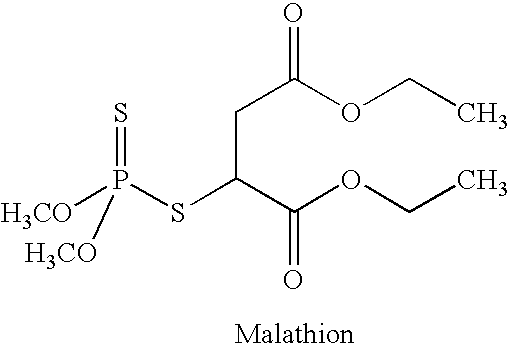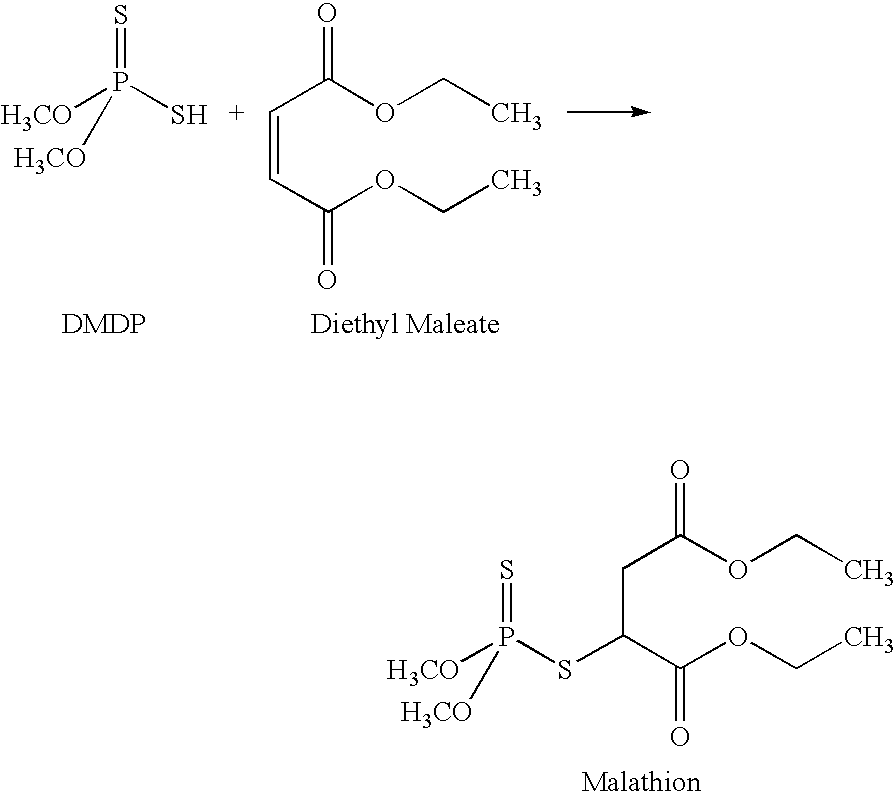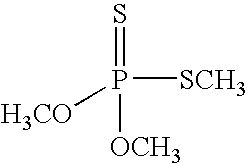Process for Preparing Malathion for Pharmaceutical Use
a technology of malathion and a process, applied in the field of preparing malathion for pharmaceutical use, can solve the problems of death, toxicity of malathion, and large amount of impurities, and achieve the effects of reducing the polymerization of diethyl maleate, purifying the malathion, and maximizing the yield and purity of the malathion
- Summary
- Abstract
- Description
- Claims
- Application Information
AI Technical Summary
Benefits of technology
Problems solved by technology
Method used
Image
Examples
example 1
Preparation of Dimethyl Dithiophosphoric Acid
[0058] Phosphorus pentasulfide (1.4 kg) and toluene (1.4 L) were combined under nitrogen in a 5-L jacketed glass reactor equipped with mechanical stirrer, and the resulting suspension was heated with stirring to about 60° C.. Methanol (1.1 L) was added dropwise over the course of four (4) hours and fifteen (15) minutes, while maintaining the temperature of the reaction mass at 67° C. or lower. The resulting gaseous H2S was trapped using an aqueous solution of sodium hypochlorite / sodium hydroxide. After complete addition of the methanol, the mixture was stirred at 55-65° C. for an additional one (1) hour.
[0059] The mixture was cooled to a temperature of 22-30° C. and the mixture was filtered to remove unreacted phosphorus pentasulfide. Additional toluene (0.3 L) was added to the resulting filtrate. The mixture was distilled under vacuum (<200 mbar) at a temperature of about 50-60° C. to remove about 600 mL of toluene. The resulting conce...
example 2
Preparation of Malathion
[0060] The solution of dimethyl dithiophosphoric acid was added to diethyl maleate (the ratio of dimethyl dithiophosphoric acid to diethyl maleate was approximately 1-1.25 kg: 1.2 kg). Hydroquinone (approximately 3 grams) was added to the mixture. The reaction mixture which contains two separate solutions, an organic solution of diethyl maleate and an aqueous solution of dimethyl dithiophosphoric acid, was mixed for about 8 hours at 53° C. under a nitrogen atmosphere. After mixing, the reaction was cooled to ambient temperature and the organic and aqueous solutions were separated. The organic or diethyl maleate solutions which contained malathion was washed two (2) times with water (approximately 1 liter each time). The organic and aqueous solutions were separated and the malathion in the solution of diethyl maleate retained. This reaction yielded approximately 1.5-1.9 kg of malathion.
example 3
Purification of the Malathion
[0061] The solution of diethylmaleate (organic) which contained the malathion (approximately 1.5-1.9 kg) was treated with about 4.6 kg of a 20% sodium bisulfite solution (aqueous) (pH 6.1 -6.3) at 60° C. for 2 hours. The mixture was cooled to ambient temperature and the organic and aqueous layers separated; the organic layer was washed with water (approximately 1.5 kg). The organic and aqueous layers were separated. The organic layer was then washed with a 0.5% NaOH solution. After separation of the two layers, the organic layer containing the malathion was washed twice with water (approximately 1 liter of water was used for each wash) to yield, approximately 0.75-0.95 kg of malathion. The purity of the malathion at this stage was determined by HPLC. If more than 5% (w / w) diethyl fumarate was present in the malathion, the material was reprocessed by treatment with the sodium bisulfite solution and water. After reprocessing, the malathion was assayed a s...
PUM
| Property | Measurement | Unit |
|---|---|---|
| temperature | aaaaa | aaaaa |
| temperatures | aaaaa | aaaaa |
| melting point | aaaaa | aaaaa |
Abstract
Description
Claims
Application Information
 Login to View More
Login to View More - R&D
- Intellectual Property
- Life Sciences
- Materials
- Tech Scout
- Unparalleled Data Quality
- Higher Quality Content
- 60% Fewer Hallucinations
Browse by: Latest US Patents, China's latest patents, Technical Efficacy Thesaurus, Application Domain, Technology Topic, Popular Technical Reports.
© 2025 PatSnap. All rights reserved.Legal|Privacy policy|Modern Slavery Act Transparency Statement|Sitemap|About US| Contact US: help@patsnap.com



